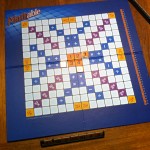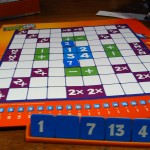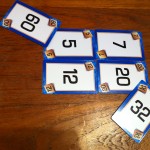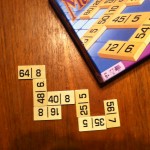A lot of the STEM-related toys and games we review here focus on science and engineering (building). This week we take a look at five entertaining games that emphasize math. They’re all from Jax, Ltd., and you can find out more at jaxgames.com/
The Game of Chips
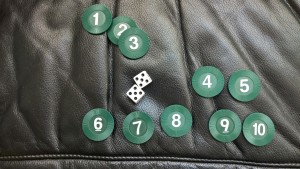 Players take turn rolling the dice and removing any combination of chips (numbered 1-10) that match what they rolled. For example, if you roll an 8, you can take out the 8, 7+1, 6+2, 5+3, 5+2+1. 4+3+1. This part of the game is a great way for young players to use and master basic addition facts. But wait—there’s a small element of strategy involved too. If it’s your turn and there aren’t enough chips left on the table to match your dice, you score the total on those chips. Low score wins. For two or more players, ages 7+. Under $8.
Players take turn rolling the dice and removing any combination of chips (numbered 1-10) that match what they rolled. For example, if you roll an 8, you can take out the 8, 7+1, 6+2, 5+3, 5+2+1. 4+3+1. This part of the game is a great way for young players to use and master basic addition facts. But wait—there’s a small element of strategy involved too. If it’s your turn and there aren’t enough chips left on the table to match your dice, you score the total on those chips. Low score wins. For two or more players, ages 7+. Under $8.
Match ‘Em
 Each player gets five cards and the first player lays one down. The next in line plays as many cards as possible to match the value of the first player’s card (similar to the matching combinations in The Game of Chips). If you can’t come up with a match, you draw two from the deck and either make a match or establish a new target. The goal, of course, is to be the first to use all your cards. To win, you’ll need a combination of luck, strategy (to make your opponents draw more cards), and a sense of humor. For 2-4 players, ages 7+. About $4.
Each player gets five cards and the first player lays one down. The next in line plays as many cards as possible to match the value of the first player’s card (similar to the matching combinations in The Game of Chips). If you can’t come up with a match, you draw two from the deck and either make a match or establish a new target. The goal, of course, is to be the first to use all your cards. To win, you’ll need a combination of luck, strategy (to make your opponents draw more cards), and a sense of humor. For 2-4 players, ages 7+. About $4.
Over and Out
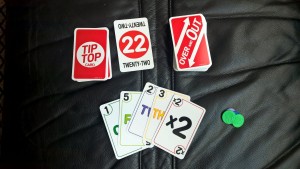 It all starts with a “Tip Top” card. Players draw cards from the deck and play cards from their own hand, keeping track of the total, and hoping not to be the one who goes over the Tip Top limit. It’s not all about addition, though. Special cards require players to subtract, or even change the Tip Top number. A fun, fast-paced way to use basic math facts and, of course, to spend time together. For 2-8 players, ages 7+. About $7.
It all starts with a “Tip Top” card. Players draw cards from the deck and play cards from their own hand, keeping track of the total, and hoping not to be the one who goes over the Tip Top limit. It’s not all about addition, though. Special cards require players to subtract, or even change the Tip Top number. A fun, fast-paced way to use basic math facts and, of course, to spend time together. For 2-8 players, ages 7+. About $7.
Polygon
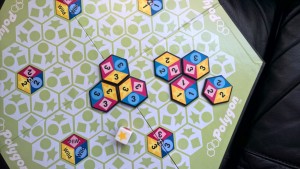 The rules of this game are sometimes a challenge to follow, but the game itself is well worth learning. Each of the six-sided pieces has three numbers and three colors and your goal is to lay down your tiles in patterns and combinations that get you the most points. Sounds simple, but this game requires a lot of thinking and strategizing. It’s also a fun way to practice basic addition and multiplication facts. For 2-4 players, ages 7+ (although it’s also a fun game to play by yourself). About $16.
The rules of this game are sometimes a challenge to follow, but the game itself is well worth learning. Each of the six-sided pieces has three numbers and three colors and your goal is to lay down your tiles in patterns and combinations that get you the most points. Sounds simple, but this game requires a lot of thinking and strategizing. It’s also a fun way to practice basic addition and multiplication facts. For 2-4 players, ages 7+ (although it’s also a fun game to play by yourself). About $16.
Sequence Numbers
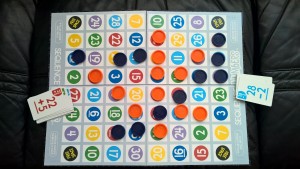 If you like the Sequence games, you already have a pretty good idea of how to play Sequence Numbers. But this one’s a little different. In the other Sequence games, you match pictures on cards with pictures on the game board. In Numbers, each card has an addition or subtraction equation and the answers are on the board. Solve the equation and put down your chip. As with other Sequence games, the goal is to get five chips in a row, up, down, or diagonally. To make it a little easier to find your answer on the board—and to help younger players double-check their math—the equations and their correct answer are printed in the same color. This is a really fun game that’ll get you and the kids thinking and laughing together as you brush up on your basic math facts. Ages 7+, 2-6 players. Around $16.50.
If you like the Sequence games, you already have a pretty good idea of how to play Sequence Numbers. But this one’s a little different. In the other Sequence games, you match pictures on cards with pictures on the game board. In Numbers, each card has an addition or subtraction equation and the answers are on the board. Solve the equation and put down your chip. As with other Sequence games, the goal is to get five chips in a row, up, down, or diagonally. To make it a little easier to find your answer on the board—and to help younger players double-check their math—the equations and their correct answer are printed in the same color. This is a really fun game that’ll get you and the kids thinking and laughing together as you brush up on your basic math facts. Ages 7+, 2-6 players. Around $16.50.

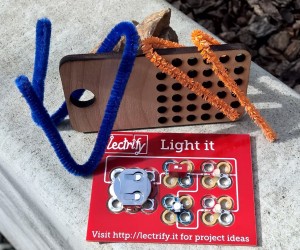 Lectrify is a new company whose mission is to “make it easy and accessible for makers of all ages to build mechanical and electronic projects.” And after trying two of their kits, we can assure you that the company is achieving that goal. The core of each kit is a fully-functional circuit board. Light It includes a battery, two LEDs, an on/off switch, and a momentary switch (like an on/off switch but it only works when you press and hold it). Shake It includes a battery, on/off switch, vibrating motor, and more. Young makers (and their parents) can experiment with the board. Then, when they’re feeling confident, they can snap the components out of the board and embed them in any project they’d like. One especially cool feature is that the circuit components are compatible with LEGO and other systems, so it’s easy to add some special features to your LEGO creations. The possibilities are unlimited, but if you want some suggestions, there are plenty on the website. For ages 5 and up (with adult supervision). Prices vary.
Lectrify is a new company whose mission is to “make it easy and accessible for makers of all ages to build mechanical and electronic projects.” And after trying two of their kits, we can assure you that the company is achieving that goal. The core of each kit is a fully-functional circuit board. Light It includes a battery, two LEDs, an on/off switch, and a momentary switch (like an on/off switch but it only works when you press and hold it). Shake It includes a battery, on/off switch, vibrating motor, and more. Young makers (and their parents) can experiment with the board. Then, when they’re feeling confident, they can snap the components out of the board and embed them in any project they’d like. One especially cool feature is that the circuit components are compatible with LEGO and other systems, so it’s easy to add some special features to your LEGO creations. The possibilities are unlimited, but if you want some suggestions, there are plenty on the website. For ages 5 and up (with adult supervision). Prices vary. 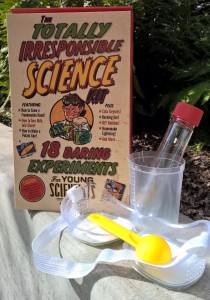 Sean Connolly has done a great service for science and math, making both subjects a lot more interesting and engaging. The titles of two of his previous books should give you an idea of his strategy: “The Book of Potentially Catastrophic Science: 50 Experiments for Daring Young Scientists” and “The Book of Perfectly Perilous Math: 24 Death-Defying Challenges for Young Mathematicians.” The experiments in this book/kit combo aren’t terribly new, but it’s the approach that counts. For example, learning how to make bubbles out of soap or generate static electricity is okay (yawn). But when you put it in terms of encasing your little brother in a giant bubble or shooting a bolt of lightning from your fingertip, now you’ve got something fun. Includes the book, a beaker, a test tube, and a measuring spoon. The rest of the ingredients you probably have around the house. For ages 7 and up. $15 on
Sean Connolly has done a great service for science and math, making both subjects a lot more interesting and engaging. The titles of two of his previous books should give you an idea of his strategy: “The Book of Potentially Catastrophic Science: 50 Experiments for Daring Young Scientists” and “The Book of Perfectly Perilous Math: 24 Death-Defying Challenges for Young Mathematicians.” The experiments in this book/kit combo aren’t terribly new, but it’s the approach that counts. For example, learning how to make bubbles out of soap or generate static electricity is okay (yawn). But when you put it in terms of encasing your little brother in a giant bubble or shooting a bolt of lightning from your fingertip, now you’ve got something fun. Includes the book, a beaker, a test tube, and a measuring spoon. The rest of the ingredients you probably have around the house. For ages 7 and up. $15 on 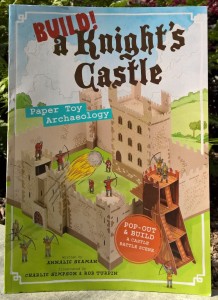 What a great way to spark in interest in archeology. You and your child start by reading about how people in medieval times lived, built their castles, and defended them. Along the way, Annalie Seaman, an archeologist and educator, shows you how to pull clues from medieval documents, paintings, maps, burial sites, scraps of metal, and more. Then, you use that knowledge to build a 3D castle using pieces that pop out of the book—knights and weapons included. For ages 5 and up. Under $11 on
What a great way to spark in interest in archeology. You and your child start by reading about how people in medieval times lived, built their castles, and defended them. Along the way, Annalie Seaman, an archeologist and educator, shows you how to pull clues from medieval documents, paintings, maps, burial sites, scraps of metal, and more. Then, you use that knowledge to build a 3D castle using pieces that pop out of the book—knights and weapons included. For ages 5 and up. Under $11 on 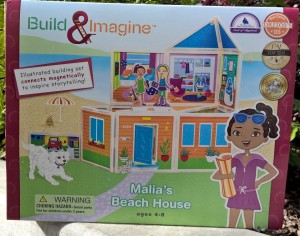 Aimed mostly at girls (although plenty of boys will enjoy it too), this constructible dollhouse helps bring out those all-important STEAM (science, technology, engineering, arts, math) skills, including building, spatial reasoning, and problem solving. Build & Imagine has a number of kits, all of which use magnetic panels and pieces and are 100% compatible with each other. This one includes Malia and Skyler dolls, 17 dual-sided, illustrated panels, and a few dozen accessories. Kids design and build their own indoor- or outdoor world. Once that’s done, they can incorporate the dolls, clothes, and other accessories and props to create any scene they’d like. For age 4 and up $60.
Aimed mostly at girls (although plenty of boys will enjoy it too), this constructible dollhouse helps bring out those all-important STEAM (science, technology, engineering, arts, math) skills, including building, spatial reasoning, and problem solving. Build & Imagine has a number of kits, all of which use magnetic panels and pieces and are 100% compatible with each other. This one includes Malia and Skyler dolls, 17 dual-sided, illustrated panels, and a few dozen accessories. Kids design and build their own indoor- or outdoor world. Once that’s done, they can incorporate the dolls, clothes, and other accessories and props to create any scene they’d like. For age 4 and up $60. 